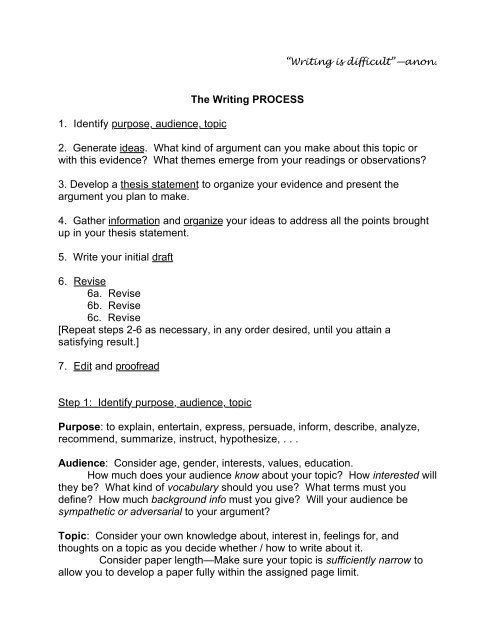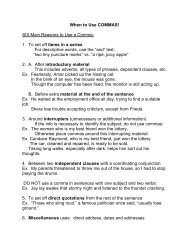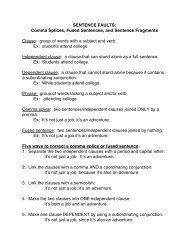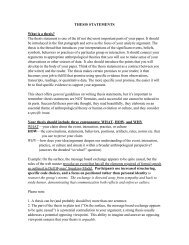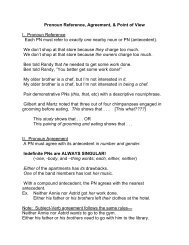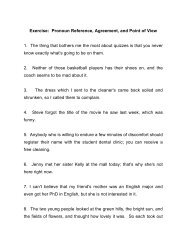The Writing PROCESS 1. Identify purpose, audience, topic 2 ...
The Writing PROCESS 1. Identify purpose, audience, topic 2 ...
The Writing PROCESS 1. Identify purpose, audience, topic 2 ...
- No tags were found...
You also want an ePaper? Increase the reach of your titles
YUMPU automatically turns print PDFs into web optimized ePapers that Google loves.
“<strong>Writing</strong> is difficult”—anon.<br />
<strong>1.</strong> <strong>Identify</strong> <strong>purpose</strong>, <strong>audience</strong>, <strong>topic</strong><br />
<strong>The</strong> <strong>Writing</strong> <strong>PROCESS</strong><br />
2. Generate ideas. What kind of argument can you make about this <strong>topic</strong> or<br />
with this evidence What themes emerge from your readings or observations<br />
3. Develop a thesis statement to organize your evidence and present the<br />
argument you plan to make.<br />
4. Gather information and organize your ideas to address all the points brought<br />
up in your thesis statement.<br />
5. Write your initial draft<br />
6. Revise<br />
6a. Revise<br />
6b. Revise<br />
6c. Revise<br />
[Repeat steps 2-6 as necessary, in any order desired, until you attain a<br />
satisfying result.]<br />
7. Edit and proofread<br />
Step 1: <strong>Identify</strong> <strong>purpose</strong>, <strong>audience</strong>, <strong>topic</strong><br />
Purpose: to explain, entertain, express, persuade, inform, describe, analyze,<br />
recommend, summarize, instruct, hypothesize, . . .<br />
Audience: Consider age, gender, interests, values, education.<br />
How much does your <strong>audience</strong> know about your <strong>topic</strong> How interested will<br />
they be What kind of vocabulary should you use What terms must you<br />
define How much background info must you give Will your <strong>audience</strong> be<br />
sympathetic or adversarial to your argument<br />
Topic: Consider your own knowledge about, interest in, feelings for, and<br />
thoughts on a <strong>topic</strong> as you decide whether / how to write about it.<br />
Consider paper length—Make sure your <strong>topic</strong> is sufficiently narrow to<br />
allow you to develop a paper fully within the assigned page limit.
Generating ideas (Prewriting)<br />
Freewriting: Focusing on an idea or piece of evidence,<br />
Set a time limit and write whatever comes to mind without pausing at all.<br />
Don’t worry about grammar, spelling, organization, etc.<br />
Harvest promising ideas from your freewriting and develop and/or narrow<br />
them with more freewriting, or other prewriting techniques.<br />
Brainstorming:<br />
Proceed as when freewriting, but using phrases rather than sentences.<br />
Try it individually or with a group.<br />
Clustering:<br />
Create a visual arrangement of ideas and logical connections.<br />
Use it to narrow <strong>topic</strong>s, locate ideas that need development, and identify<br />
the logical and hierarchical relationships among ideas.<br />
Keeping a journal Answering questions (ask who what when where why of<br />
your <strong>topic</strong>)<br />
Formulating your thesis statement<br />
broad area of interest children’s games<br />
<strong>topic</strong><br />
question to answer<br />
rules and structure of the game<br />
How are the Dani people’s values and<br />
interpersonal relationship styles reflected in<br />
the rules and structure of the stick game<br />
thesis statement<br />
Children’s distraction and fluid partnering during<br />
the stick game, as well as their acceptance of<br />
other children’s interference, suggest that<br />
Dani culture is minimally competitive and<br />
values the independence of the individual.<br />
Your thesis statement should<br />
Narrow your <strong>topic</strong> to a single main idea;<br />
Assert a position;<br />
Express your opinion and attitude about the <strong>topic</strong>;<br />
Stimulate curiosity in your readers;<br />
Fit your <strong>purpose</strong>.<br />
Organizing ideas—OUTLINING
<strong>The</strong> difference between a well organized paper and a holy mess<br />
generally lies in the outline.<br />
An outline does NOT have to be sophisticated; it only needs to show levels of<br />
ideas and the order in which you will write about them.<br />
BEFORE writing: <strong>1.</strong> List all the points you want to make.<br />
2. Group them according to relationships.<br />
3. Decide which ideas are major and minor / main <strong>topic</strong>s and<br />
sub<strong>topic</strong>s.<br />
4. Decide the order in which you want to cover the <strong>topic</strong>s.<br />
5. Indicate logical connections/transitions between them.<br />
DURING writing: outline what you have written so far when you are stuck, or to<br />
make sure you are staying on <strong>topic</strong>.<br />
<strong>Writing</strong> your first DRAFT—some helpful and unorthodox tips<br />
Don’t begin at the beginning: start with the section/point that seems<br />
easiest to you, work to the end, then write your intro.<br />
Write quickly. Get your ideas down as quickly as possible, without<br />
worrying too much about grammar, perfect word choice, spelling, etc.<br />
Write strongly. Capture your initial passion and excitement about<br />
the ideas, or else you’ll lose them. You can tone down your writing later.<br />
Save all drafts and notes. Save both hard and electronic copies,<br />
betting on the worst (it happens). Save multiple versions of your drafts, as you<br />
may decide to revisit ideas you’ve already deleted.<br />
When you take breaks—finish a section or try to exhaust your<br />
current thoughts; if not, make notes about what you want to say next.<br />
Write where you are free from distractions. You’ll get more done in<br />
two intense hours of work than in six hours of interruptions by friends, phone,<br />
TV, email, etc. Don’t waste your time.<br />
Set deadlines, plan breaks, break up your work hours. Setting<br />
aside a whole day to write a paper usually results in getting little done—the idea<br />
of spending an entire day writing a paper is just too awful. Plan shorter work<br />
periods with rewards at the ends of them. (Start early.)<br />
When all else, fails, take a shower—or do whatever makes your<br />
brain juices flow. Run. Sing. Sniff a rotten apple.<br />
Stages of REVISION<br />
I. BIG STUFF: <strong>The</strong>sis statement (clarity, location, effectiveness), logical
fallacies, assignment parameters<br />
II. Overall organization<br />
A. Unity<br />
--Does each paragraph have a clear <strong>topic</strong> sentence<br />
--Does each sentence relate to that <strong>topic</strong> sentence<br />
--Does each <strong>topic</strong> sentence relate to the thesis statement<br />
B. Development<br />
--Is each <strong>topic</strong> sentence sufficiently developed<br />
--Does the essay provide enough evidence and supporting detail for<br />
the thesis statement too much<br />
C. Coherence<br />
--Does each paragraph lead logically into the next Are there any<br />
gaps in logic within or between paragraphs<br />
III. Introduction, conclusion, and title<br />
IV. Style—sentence variety, word choice, conciseness, action, parallelism, etc.<br />
Is the essay lively, engaging, and original<br />
Stages of EDITING<br />
I. Sentence faults (comma splices, fused sentences, fragments)<br />
II. Pronoun use (vague PNs, PN shifts, PN agreement)<br />
III. Punctuation (especially apostrophes and commas)<br />
IV. Subject-verb agreement; other grammatical problems<br />
PROOFREADING<br />
Check for format (spacing, font, margins, page numbers, etc.), spelling,<br />
typographical errors, homonym mistakes, etc.<br />
Tips to help you catch your errors:<br />
<strong>1.</strong> Read your paper aloud.<br />
2. Use a ruler to help you focus on one line at a time.<br />
3. Read the paper backwards, sentence by sentence.<br />
**4. PUT YOUR PAPER AWAY FOR A WHILE before you proofread


